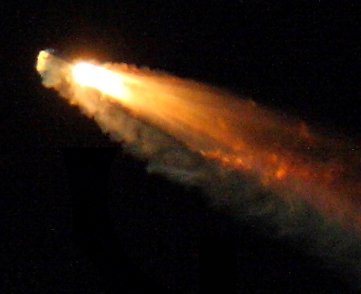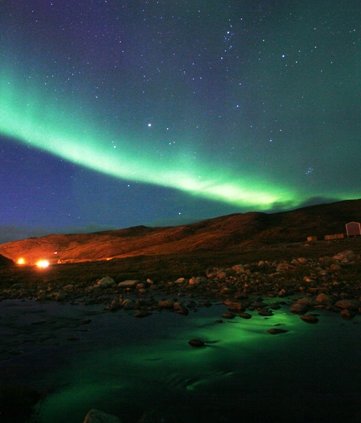| SOLAR PROMINENCE: Amateur astronomers are reporting a large and active prominence dancing along the northeastern limb of the sun. Readers who have solar telescopes are encoluraged to look. images: from Mark Townley of Brierley Hill, West Midlands, UK; from Stephen Ames of Hodgenville, KY; from Fabio Mariuzza of Biauzzo-Codroipo, Italy; from Cai-Uso Wohler of Bispingen, Germany; from Emiel Veldhuis of Zwolle, the Netherlands SHUTTLE MISSION BEGINS: Discovery has left the planet. The space shuttle lifted off from Kennedy Space Center one minute before midnight on Friday, Aug. 28th, in a launch that was as flawless as it was beautiful. Pete Lardizabal watched the flight through a 5-inch telescope in St Johns, Florida: 
"I caught the shuttle just as it was dropping its spent solid rocket boosters (SRBs)," he says. "This series shows what it looked like before, during, and after the SRBs were shed." Discovery is now in orbit chasing the International Space Station for a Sunday night rendevous. The shuttle is on a science supply mission. It is carrying high-tech equipment to outfit the station's laboratories. The payload includes new tools for fluid physics research, a -80 degree laboratory freezer, and equipment to study materials such as semiconductors, ceramics, alloys and crystals in low gravity. The mission marks the start of the transition from assembling the
space station to using it for continuous scientific research.
Until now, assembly and maintenance activities have kept the station's crew almost fully occupied, but as completion of the ISS nears, time is being freed up for science experiments. Soon, the ISS is about to realize its potential as a world-class low gravity research laboratory. Readers, check the Simple Satellite Tracker for flybys of Discovery and the ISS over your home town! more images: from Mike Deep of Banana Creek VIP Site, KSC, FL; from Andrew Boyle of Orlando, Florida; from Bobby Lacey of Jekyll Island, Georgia; from Joseph Daly of Cocoa Beach, Florida; from Victor van Wulfen of Space View Park, Titusville, Florida; from Ron Netzley of Palm Bay Florida; from Richard Fleet of Pewsey Vale, Wiltshire, UK; from Jonathan Sabin of Bradenton, Florida; from Jonathan Bingham of Killead Co. Antrim, Northern Ireland; from Martin Wagner of 72820 Sonnenbuehl-Genkingen, Germany; from John C McConnell of Maghaberry, Northern Ireland; from Peter McCabe of Dundalk, Co.Louth, Ireland; from George Anderson of Wokingham, Berkshire, England, UK; ARCTIC AURORAS: There are some places on Earth where all you have to do to see the Northern Lights is ... to want to. The Inuit village of Salluit in Nunavik, Canada, is such a place. On most clear nights at least a hint of auroras--and often much more than a hint--can be found in the sparkling midnight sky. Salluit resident Sylvain Serre took this picture on August 27th: 
"With a clear sky and very good weather, I decided to go outside and take some pictures of the Northern Lights--and there they were," he says. Salluit is located under Earth's persistent auroral oval, a luminous ring circumscribing the north magnetic pole. Our planet's magnetic field guides particles from space into the oval and voila!--Northern Lights. No geomagnetic storm is required. August 2009 Aurora Gallery
[previous Augusts: 2008, 2007, 2006, 2005, 2004, 2003, 2002, 2001]
Explore the Sunspot Cycle | 
